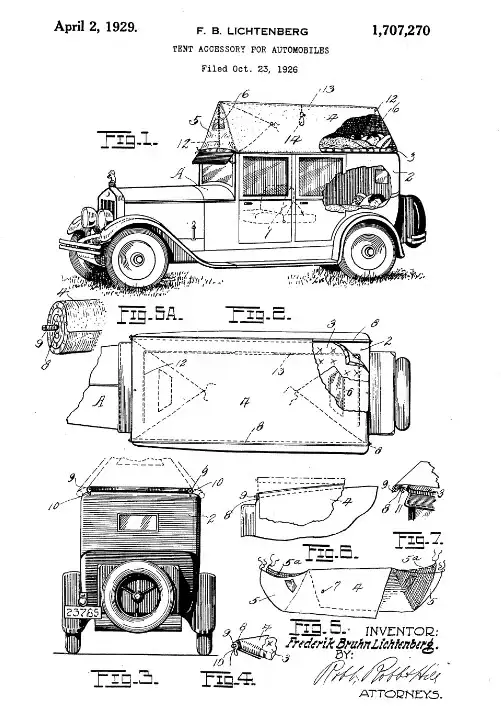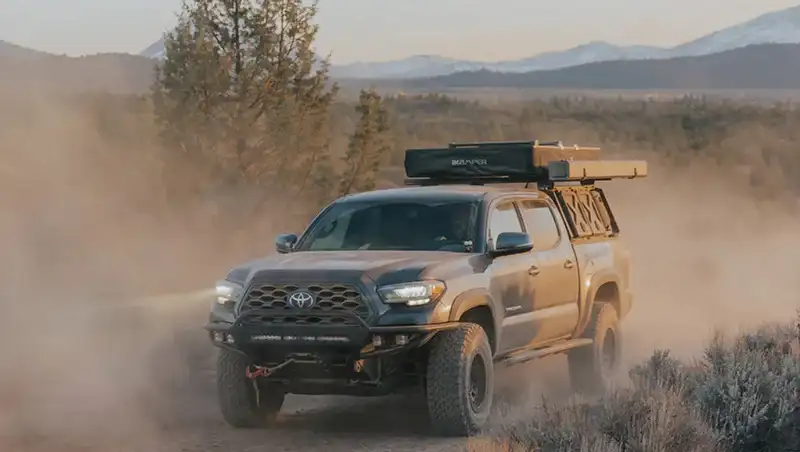As someone who loves camping, I’ve always been fascinated by the different ways people have found to sleep outdoors. From classic dome tents to hammocks and bivy sacks, there are so many options out there.
However, one type of tent has caught my attention in recent years: roof top tents. In this article, I’ll take you on a short journey through the history of roof top tents.
The Early Days – It All Started in Italy
Roof-top tents are one of off-ground tents. Believe it or not, roof top tents have been around for quite some time.
I have seen some statements that their origin is in the Australian Outback. Apparently, early explorers would use them to keep themselves safe from the dangerous creatures that roamed the wilderness.
But it turns out this is not so. According to Wikipedia, this all started in Italy somewhere in 1936 or 1937.
The idea behind the roof tent was simple but revolutionary: why not attach a tent to the roof of a car, creating a sense of freedom and independence for travelers?
Now, see the screenshot below which is from Popular Science, and the year is 1937.

If you are curious about the car, this is the famous Fiat 500 Topolino.
However, I have seen also a patent by Frederick B. Lichtenberg’s RTT design from 1926 that shows a roof top tent. In the description he writes:
“Mv invention of course aims to provide a handy shelter or tent that may be used as a sleeping compartment, auxiliary to the compartment which may be provided by the interior of the coach or sedan type car with which it may be employed…”
See what he had in mind:

There are many more patents from the period after the second world war, you can find them listed in an article. But from what I see, it seems that none of them (including the Lichtenberg RTT) resulted in actual rooftop tents.
l have seen also some writing about the 1949 Nash roof top tent, but could not find anything in detail about it.
From a text that I found at Autohome site, the roof tent called the “Auto-Campeggio Stogl,” was patented in 1958 by Stefano Stogl. This was an actual RTT that they built for the market.
It was designed to be installed as a simple roof rack on any vehicle. With just a simple handle, the tent could be opened in just 20 seconds, making it easy to set up camp wherever you were.
There were two main designs for the roof tent at the time: the vertical lifting tent and the lateral hinged folding tent. Sounds familiar?
The former became the ancestor of the current “Maggiolina” tent. The latter became the “Air-Camping” tent, patented by Giuseppe Dionisio (also known as Gidion) in 1959. See them in the picture which I found at the mentioned Autohome site:

It is incredible that the soft-shell model on the right was used on the smallest auto from that time, Fiat Cinquecento.
As you see, this is essentially the same design used in expandable roof top tents of that type that are around these days. The modern iKamper X Cover 2.0 tent shown in the top picture above follows the same logic.
The same holds for the model on the left in the picture, this is what we describe as a pop-up roof top tent.
Both tent designs were a huge success at the time, and remain popular today thanks to their ingenious and innovative design. As we all know, over the years, the roof tent has become an essential travel accessory, with numerous models and styles to choose from.
As time went on, roof top tents began to gain popularity in other parts of the world. In Africa, for example, they were used as a way to stay safe from lions and other big cats.
Air-Camping RTT brand has the history of their roof top tents that goes back for many decades, they starting in 1959.
The Modern Era
While roof top tents have been around for a long time, it’s only in recent years that they’ve really taken off in popularity.
One of the reasons for this is the rise of overlanding, a type of off-road travel that involves driving to remote locations and camping out in the wilderness.
Roof top tents are a perfect match for overlanding, as they allow you to set up camp quickly and easily wherever you happen to be. They also offer a number of advantages over traditional ground tents, including:
- Better views: Sleeping up high means you can enjoy stunning views of the surrounding landscape.
- Increased safety: Being off the ground means you’re less likely to be bothered by animals or insects.
- More comfortable sleeping: Roof top tents often have thicker mattresses and better ventilation than traditional tents.
As roof top tents have become more popular, manufacturers have started to innovate in terms of features. But clearly the essential design remains the same, and the same holds for material. Fiberglass was used for such tents already in 1958.
Though there are innovations regarding the materials. Did you know that there are even air-beam or inflatable roof top tents?
One of the most important development in my view is related to annexes, which are essential additional rooms that can be attached to the main tent. This is great for families or groups who need a bit more space.
Choosing the Right Roof Top Tent
If you’re thinking about getting a roof top tent, there are a few things you’ll need to consider. Here are some tips to help you make the right choice:
- Size: Make sure you choose a tent that’s big enough to comfortably sleep everyone who will be using it.
- Weight: Roof top tents can be heavy, so make sure you choose one that’s appropriate for your vehicle.
- Price: Roof top tents can be expensive, so make sure you’re getting good value for your money.
Conclusion
Roof top tents have come a long way since their early days in Italy in the period between the two world wars, and after the second world war.
Today, they’re a popular choice for camping enthusiasts who want to be able to set up camp quickly and easily wherever they happen to be.
With a range of innovative designs and features available, there’s a roof top tent out there for everyone. So why not give one a try and see what all the fuss is about?
Let me know if you have questions, there is a comment box below. For more texts in this category please check under Off-Ground Tents.
Bookmark this site and keep as a reference. You will always have new texts added here and this will keep you informed. Thank you for reading and have a nice day.

